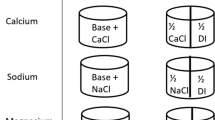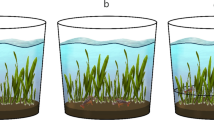Abstract
New Zealand mud snails (NZMS) are exotic mollusks present in many waterways of the western United States. In 2009, NZMS were detected in Redwood Creek in Redwood National Park, CA. Although NZMS are noted for their ability to rapidly increase in abundance and colonize new areas, after more than 5 years in Redwood Creek, their distribution remains limited to a ca. 300 m reach. Recent literature suggests that low specific conductivity and environmental calcium can limit NZMS distribution. We conducted laboratory experiments, exposing NZMS collected from Redwood Creek to both natural waters and artificial treatment solutions, to determine if low conductivity and calcium concentration limit the distribution of NZMS in Redwood National Park. For natural water exposures, we held NZMS in water from their source location (conductivity 135 μS/cm, calcium 13 mg/L) or water from four other locations in the Redwood Creek watershed encompassing a range of conductivity (77–158 μS/cm) and calcium concentration (<5–13 mg/L). For exposures in treatment solutions, we manipulated both conductivity (range 20–200 μS/cm) and calcium concentration (range <5–17.5 mg/L) in a factorial design. Response variables measured included mortality and reproductive output. Adult NZMS survived for long periods (>4 months) in the lowest conductivity waters from Redwood Creek and all but the lowest-conductivity treatment solutions, regardless of calcium concentration. However, reproductive output was very low in all natural waters and all low-calcium treatment solutions. Our results suggest that water chemistry may inhibit the spread of NZMS in Redwood National Park by reducing their reproductive output.




Similar content being viewed by others
References
Alonso A, Castro-Diez P (2008) What explains the invading success of the aquatic mud snail Potamopyrgus antipodarum? Hydrobiologia 614:107–116
Alonso Á, Castro-Díez P (2012) The exotic aquatic mud snail Potamopyrgus antipodarum (Hydrobiidae, Mollusca): state of the art of a worldwide invasion. Aquat Sci 74:375–383
Benson AJ, Kipp RM, Larson J, Fusaro A (2015) Potamopyrgus antipodarum. USGS Nonindigenous Aquatic Species Database, Gainesville, FL. http://nas.er.usgs.gov/queries/FactSheet.aspx?speciesID=1008. Retrieved 4 Jan 2015
Bersine K, Brenneis VEF, Draheim RC, Rub AMW, Zamon JE, Litton JR, Hinton SA, Sytsma MD, Cordell JR, Chapman JW (2008) Distribution of the invasive New Zealand mudsnail (Potamopyrgus antipodarum) in the Columbia River Estuary and its first recorded occurrence in the diet of juvenile Chinook salmon (Oncorhynchus tshawytscha). Biol Invasions 10:1381–1388
Brenneis VEF, Sih A, de Rivera CE (2011) Integration of an invasive consumer into an estuarine food web: direct and indirect effects of the New Zealand mud snail. Oecologia 167:169–179
Bruce RL, Moffitt CM (2010) Quantifying risks of volitional consumption of New Zealand mud snails by Steelhead and Rainbow Trout. Aquac Res 41:552–558
Calow P, Forbes VE (1998) How do physiological responses to stress translate into ecological and evolutionary processes? Comp Biochem Phys A 120:11–16
Couland R, Mouthon J, Queau H, Charles S, Chaumot A (2013) Life-history phenology strongly influences population vulnerability to toxicants: a case study with the mudsnail Potamopyrgus antipodarum. Environ Toxicol Chem 32(8):1727–1736
Dalesman S, Lukowiak K (2010) Effect of acute exposure to low environmental calcium on respiration and locomotion in Lymnaea stagnalis (L.). J Exp Biol 213:1471–1476
Drown DM, Levri EP, Dybdahl MF (2010) Invasive genotypes are opportunistic specialists not general purpose genotypes. Evol Appl 4:132–143
Dybdahl MF, Kane SL (2005) Adaptation vs. phenotypic plasticity in the success of a clonal invader. Ecology 86(6):1592–1601
Fox JA, Dybdahl MF, Jokela J, Lively CM (1996) Genetic structure of coexisting sexual and clonal subpopulation in a freshwater snail (Potamopyrgus antipodarum). Evolution 50(4):1541–1548
Gerard C, Blanc A, Costil K (2003) Potamopyrgus antipodarum (Mollusca:Hydrobiidae) in continental aquatic gastropod communities: impact of salinity and trematode parasitism. Hydrobiologia 493:167–172
Hall RO Jr, Tank JL, Dybdahl MF (2003) Exotic snails dominate nitrogen and carbon cycling in a highly productive stream. Front Ecol Environ 1(8):407–411
Harding JS, Winterbourn MJ (1995) Effects of contrasting land use on physico-chemical conditions and benthic assemblages of streams in a Canterbury (South Island, New Zealand) river system. N Z J Mar Freshw Res 29:479–492
Hellmair M, Goldsmith G, Kinziger AP (2011) Preying on invasives: the exotic New Zealand mudsnail in the diet of the endangered tidewater goby. Biol Invasions 13:2197–2201
Herbst DB, Bogan MT, Lusardi RA (2008) Low specific conductivity limits growth and survival of the New Zealand mud snail from the Upper Owens River, California. West N Am Nat 68:324–333
Hoy M, Boese BL, Taylor L, Reusser D, Rodriguez R (2012) Salinity adaptation of the invasive New Zealand mud snail (Potamopyrgus antipodarum) in the Columbia River estuary (Pacific Northwest, USA): physiological and molecular studies. Aquat Ecol 46:249–260
Jacobsen R, Forbes VE (1997) Clonal variation in life-history traits and feeding rates in the gastropod, Potamopyrgus antipodarum: performance across a salinity gradient. Funct Ecol 11:260–267
Kerans BL, Dybdahl MF, Gangloff MM, Jannot JE (2005) Potamopyrgus antipodarum: distribution, density, and effects on native macroinvertebrates assemblages in the Greater Yellowstone Ecosystem. J N Am Benthol Soc 24:123–138
Kolosovich AS, Chandra S, Saito L, Davis CJ, Atwell L (2012) Short-term survival and potential grazing effects of the New Zealand mudsnail in an uninvaded Western Great Basin watershed. Aquat Invasions 7(2):203–209
Levri EP, Krist AC, Bilka R, Dybdahl MF (2014) Phenotypic plasticity of the introduced New Zealand mud snail, Potamopyrgus antipodarum, compared to sympatric native snails. PLoS ONE 9(4):e93985
McKenzie VJ, Hall WE, Guralnick RP (2013) New Zealand mudsnails (Potamopyrgus antipodarum) in Boulder Creek, Colorado: environmental factors associated with fecundity of a parthenogenic invader. Can J Zool 91:30–36
Schmidlin S, Schmera D, Baur B (2012) Alien molluscs affect the composition and diversity of native macroinvertebrates in a sandy flat of Lake Neuchatel, Switzerland. Hydrobiologia 679:233–249
Sepulveda AJ, Marczak LB (2012) Active dispersal of an aquatic invader determined by resource and flow conditions. Biol Invasions 14:1201–1209
Sytsma MD, Cordell JR, Chapman JW, Draheim RC (2004) Lower Columbia River aquatic nonindigenous species survey 2001–2004. Final Technical Report, United States Coast Guard and the United States Fish and Wildlife Service, Portland OR, p 78. Available from http://www.clr.pdx.edu/projects/columbia/lcrans.php
Vinson, Mark (2004) The occurrence and distribution of New Zealand mud snail (Potamopyrgus antipodarum) in Utah. Final report for Utah Department of Natural Resources, Division of Wildlife Resources, Salt Lake City, UT
Wallace C (1992) Parthenogenesis, sex and chromosomes in Potamopyrgus. J Molluscan Stud 58:93–107
Ward DM, Sepulveda A (2014) A race against time: Establishing baseline data on redwood ecosystem food webs before New Zealand mud snails invade. Report. Save The Redwoods League
Winterbourn M (1970) The New Zealand species of Potamopyrgus (Gastropoda: Hydrobiidae). Malacologia 10:283–321
Acknowledgments
We thank Heather Daniels, Jimmy Garcia, Kachina Rowland, and Pamela Ward for their help in the field surveys and Sherry Mason and Kachina Rowland for their help with snail husbandry. The National Science Foundation’s Undergraduate Research and Mentoring Program in the Biological Sciences, Grant Number DBI-0934022, Save the Redwoods League Research Grant Program, and the National Oceanographic and Atmospheric Administration’s Cooperative Institute for Marine Ecosystems and Climate provided funding for this project. Any use of trade, product, or firm names is for descriptive purposes only and does not imply endorsement by the U.S. Government.
Author information
Authors and Affiliations
Corresponding author
Rights and permissions
About this article
Cite this article
Vazquez, R., Ward, D.M. & Sepulveda, A. Does water chemistry limit the distribution of New Zealand mud snails in Redwood National Park?. Biol Invasions 18, 1523–1531 (2016). https://doi.org/10.1007/s10530-016-1098-1
Received:
Accepted:
Published:
Issue Date:
DOI: https://doi.org/10.1007/s10530-016-1098-1




